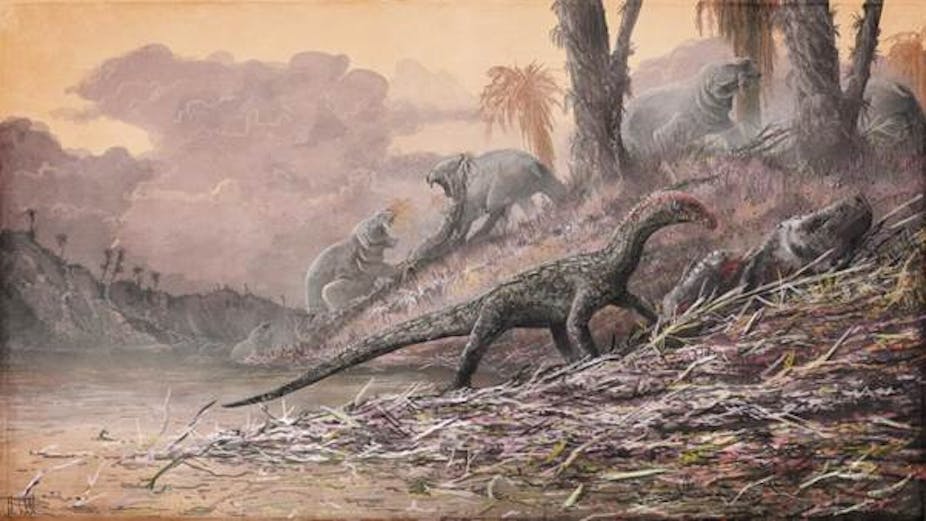What did the ancestors of dinosaurs look like? For decades, our knowledge of close dinosaur relatives has been based largely on animals like the Triassic Period reptile Marasuchus, a tiny, squirrel-sized critter that moved rapidly on two legs.
Dinosaur ancestors, according to the conventional story, looked much like dinosaurs, just shrunken down to the size of something you might accidentally squash under your foot. However, in a new paper in the journal Nature, my colleagues and I describe a new species of Triassic reptile, Teleocrater rhadinus, which fundamentally challenges this status quo of dinosaur origins.
Dinosaurs appeared during the Triassic Period, with the oldest uncontroversial dinosaur fossils being about 230m years old. Unfortunately, early dinosaur fossils are so rare that many theories about their origins and rise to global dominance are controversial.
One thing we are pretty sure about is that dinosaurs belong to a major branch of the reptile evolutionary tree that also includes birds, pterosaurs, and the dinosaur-like reptiles known as dinosauromorphs (like Marasuchus). The scientific name for this great evolutionary lineage is Avemetatarsalia, or “bird-feet”.
Our research suggests that the new species, Teleocrater, is the oldest known member of this important group. Although this does not make Teleocrater a direct ancestor of dinosaurs, rather a close cousin, it still gives us clues to what those ancestors might have looked like.

Unlike some advances in palaeontology, our work wasn’t based on the discovery of a single new fossil but instead involved piecing together evidence from several specimens. These fossils come from the southern part of Tanzania, in East Africa, and are from rocks of the Middle Triassic age, dating to around 245m years ago. They include an incomplete skeleton in the collections of the Natural History Museum in London, which was discovered in the early 20th century, as well as much more recent discoveries made by my US and South African colleagues.
Together, these important fossils allow us to reconstruct Teleocrater as a predator between two and three metres long that probably walked on four legs, and was rather Komodo dragon-like in appearance. It was certainly very different to the tiny, fast-running bipeds normally associated with dinosaur origins.
Mosaic reconstruction
The anatomy of Teleocrater is a surprising mosaic. Some bones, such as the very long neck vertebrae, are very similar to those of early dinosaurs. Others, such as the crocodile-like ankle bones, are much more primitive. As such, this new species helps us to understand how the highly distinctive body plan of dinosaurs evolved over time.
Teleocrater seems to be highly similar to a number of other reptile species that have been named previously from rocks of similar age in India, Russia and Brazil. Most of these species have been enigmatic and difficult to understand, but our work suggests that together they form a previously unrecognised group of dinosaur cousins. We named this group Aphanosauria, or “hidden lizards”, referring to the fact that these animals have been hiding in plain sight. They had been given scientific names by palaeontologists, but their evolutionary importance for dinosaur origins had not been realised.

The story of the discovery of Teleocrater highlights the importance of museum collections, and the continued reassessment of historical fossil specimens. The first specimen of Teleocrater was collected by Cambridge palaeontologist Francis Rex Parrington in the 1930s. Alan Charig, who for many years was the Curator of Fossil Reptiles at the Natural History Museum, studied the fossils of Teleocrater for his PhD in the 1950s.
Although he realised their importance, Charig never completed his research on the specimens, and when he died in the late 1990s, his work remained unpublished. By restudying these specimens that have sat in museum collections for more than 80 years, my colleagues and I have finally managed to reveal their true scientific significance. Moreover, we were able to recognise Charig’s work by including him as a co-author on the research.
Our work is part of a number of recent discoveries and analyses that suggest that we might have to completely rethink our models of dinosaur origins. Teleocrater raises the possibility that dinosaur ancestors might have been considerably larger than previously thought, slower moving, and quadrupedal rather than bipedal.
As so often in palaeontology, sorting through alternative theories about what dinosaur ancestors looked like will probably require additional fossil discoveries. These may come from new fieldwork, but it’s also possible that the answers might already be lying in a museum drawer somewhere, waiting to catch the right palaeontological eye. Let’s just hope it doesn’t take another 80 years.

